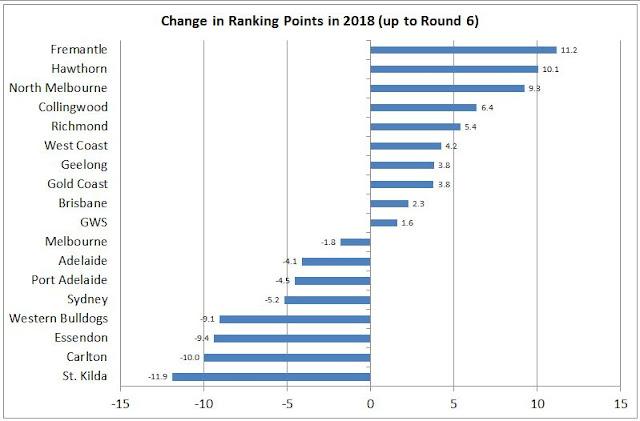Fremantle,
Hawthorn, and North Melbourne are rated as the biggest improvers so far in
2018. What are they doing better?
This week I had added back
into the Power Rankings table each team’s change in Ranking Points over the 2018
season to date, as we are now enough weeks into the season for it to be
somewhat meaningful.
So far in 2018 the Power
Rankings rate the biggest improvers
as Fremantle (+11.2 ranking points –
see chart below), Hawthorn (+10.1),
and North Melbourne (+9.3). Freo and
North are still rated as ‘below average’ mainly due to their performances in 2017,
while Hawthorn has gone from ‘average’ to ‘good’.
The biggest declines in performance, according to the Rankings, are
from St. Kilda (-11.9), Carlton (-10.0), Essendon (-9.4), and the Western
Bulldogs (-9.1). St. Kilda, Essendon and the Bulldogs have gone from being
rated ‘average’ to ‘below average’, while Carlton is now ‘well below average’.
I could end it there for this
week, but I thought it would also be informative to borrow (or filch) a concept
from the excellent HPN
Footy website to see in which parts of the field these teams
have improved. Basically HPN rate
each team’s midfields, offence, and defence as follows:
·
Midfield – how often a team gets the ball into
attack compared with how often their opposition gets it into attack;
·
Offence – how often a team scores when it gets
the ball into attack;
·
Defence – how often a team stops the other team
from scoring when the other team goes into attack.
‘Attack’ here is defined as
getting the ball into your 50 metre zone, which is a statistic that is commonly
available. These ratings are obviously not meant to explain everything that
goes on in a football match, but they do give a good, quick overview of where
each side is generally ‘winning the battle’. Note that I’m going to vary
slightly from the HPN method here, in that I’m going to use points per inside
50 to measure offence and defence and not adjust for opposition strength, but I
don’t think it will matter too much for showing where each team has improved or
declined.
Based on these ratings, the
biggest improvements from Fremantle and Hawthorn have been their ability to get
the ball into attack (their ‘midfield rating’). For North Melbourne it’s been
their ability to stop the other team scoring once it gets into attack – a topic which was covered in
much more detail by HPN itself last week.
For the big decliners, St.
Kilda has been relatively awful in scoring once it gets the ball inside its own
50 metre zone. Essendon has been mainly worse at defending, the Bulldogs at
winning the midfield contest and defending, and Carlton at both kicking goals
and stopping them.
Of course teams don’t just
go through changes in performances between
seasons, but also changes within them.
We’ll see the Rankings’ cross-season comparisons swing about many times
throughout the year, but this shows which teams appear to be headed in the
right direction.











